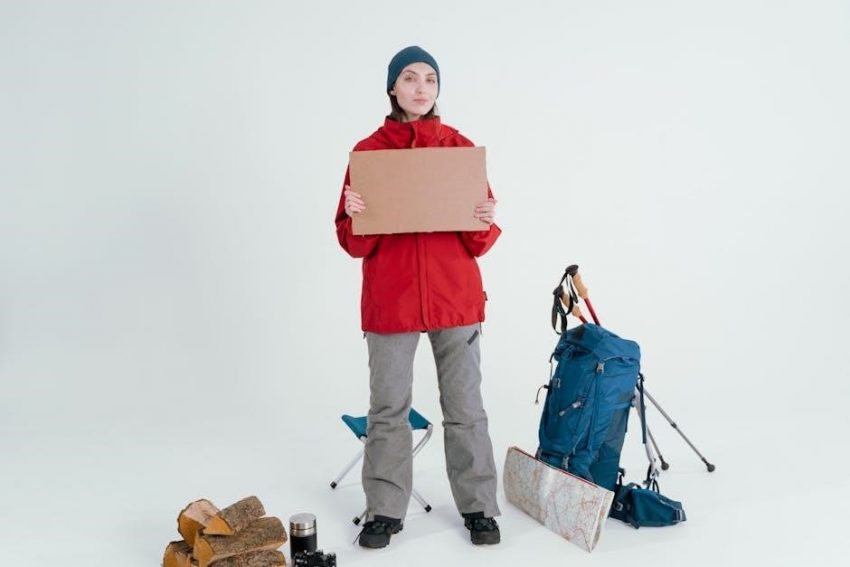Developed in the 1930s by The Mountaineers‚ a Seattle hiking club‚ the 10 Essentials for Hiking ensure safety and preparedness for emergencies or unexpected nights outdoors.
Why the 10 Essentials Are Crucial for Hiking Safety
The 10 Essentials for Hiking are fundamental for ensuring safety and preparedness in the wilderness. They minimize risks associated with unexpected situations‚ such as injuries‚ harsh weather‚ or getting lost. Originally developed to help hikers survive overnight stays or emergencies‚ these items address critical needs like navigation‚ hydration‚ and warmth. By carrying them‚ hikers can respond effectively to challenges‚ reducing the likelihood of dire outcomes. The essentials serve as a proactive approach to safety‚ ensuring that adventurers are equipped to handle the unpredictable nature of the outdoors. They are indispensable for every hike‚ regardless of length or difficulty.

Appropriate Footwear
Sturdy‚ waterproof hiking boots or trail shoes provide essential support and protection for various terrain and weather conditions‚ ensuring comfort and preventing injuries during hikes.
Definition and Importance
Appropriate footwear refers to sturdy‚ waterproof hiking boots or trail shoes designed for varying terrain and weather conditions. It is crucial for providing ankle support‚ protecting feet from rough surfaces‚ and preventing injuries. Proper footwear ensures comfort during long hikes‚ prevents blisters‚ and improves stability on uneven or slippery paths. For short‚ lightweight hikes‚ trail shoes suffice‚ while backpacking or technical terrain requires more robust boots. Footwear is the foundation of a safe and enjoyable hiking experience‚ as it directly impacts mobility and overall well-being on the trail. Prioritizing the right footwear minimizes risks and enhances confidence for hikers of all skill levels.
Choosing the Right Footwear
Selecting the right footwear depends on the hike’s duration‚ terrain‚ and load. For short‚ lightweight hikes on smooth trails‚ trail running shoes or lightweight hiking shoes are ideal. For longer hikes with heavy backpacks or challenging terrain‚ sturdy hiking boots with ankle support are recommended. Waterproofing is essential for wet conditions‚ while breathability matters in hot weather. Ensure a proper fit by trying shoes late in the day‚ as feet swell during hikes. Avoid tight or loose fits to prevent blisters. Consider moisture-wicking socks for added comfort. The right footwear enhances stability‚ reduces fatigue‚ and ensures a safer‚ more enjoyable hiking experience. Always break in new shoes before a long hike to avoid discomfort.
Tips for Footwear Maintenance
Proper footwear maintenance extends the lifespan of your hiking shoes and ensures optimal performance. After each hike‚ clean your shoes with a soft brush and mild soap to remove dirt and debris. Allow them to air-dry naturally‚ avoiding direct sunlight or heat sources‚ which can damage materials. Apply waterproofing spray or wax regularly to protect against moisture. Store your shoes in a cool‚ dry place to prevent mold and mildew. Inspect soles for wear and replace them if necessary. For leather boots‚ condition them periodically to maintain flexibility. Regular maintenance ensures your footwear remains durable‚ comfortable‚ and ready for your next adventure.
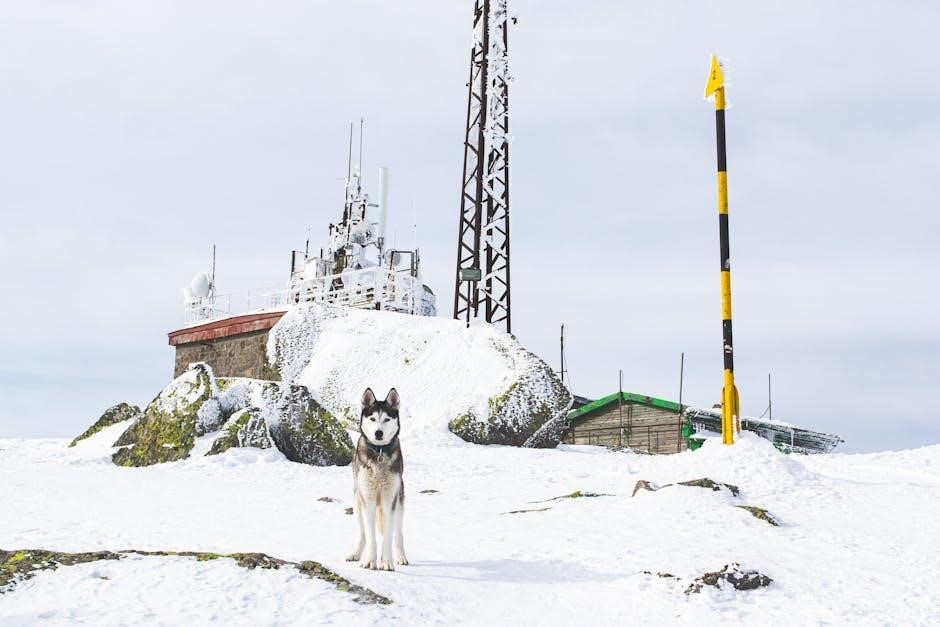
Navigation Tools
Navigation tools like maps‚ compasses‚ and GPS devices are crucial for staying on track and finding your way‚ especially in remote or unfamiliar terrain.
Map‚ Compass‚ and GPS
A detailed topographic map provides essential information about terrain‚ trails‚ and landmarks. A compass is crucial for determining direction‚ especially in low-visibility conditions. GPS devices offer precise location data but require batteries. Together‚ these tools help hikers navigate accurately and find their way back if lost. Always carry extra batteries for GPS and compass. While GPS is modern and convenient‚ a map and compass remain reliable backups. Practice using these tools before heading out to ensure proficiency. Combining all three enhances safety and confidence on the trail‚ making them indispensable components of the 10 Essentials for Hiking.
How to Use Navigation Tools Effectively
Mastering navigation tools is vital for safe hiking. Always orient your map with the surrounding landscape to align landmarks and trails. Use the compass to determine direction‚ ensuring the needle points north. For GPS‚ input waypoints and track your route to avoid getting lost. Regularly check your position against the map to stay on course. In challenging conditions‚ rely on triangulation with visible landmarks. Practice these skills before your hike to build confidence. Carry extra batteries and know how to use your devices in low-light conditions. By combining map‚ compass‚ and GPS effectively‚ you can navigate even the most unfamiliar terrain with ease and accuracy.
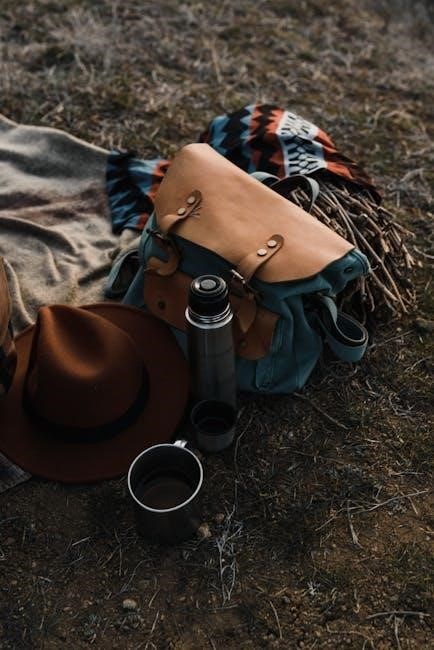
Extra Clothing
Extra clothing is crucial for adapting to changing weather conditions. Pack moisture-wicking base layers‚ breathable mid-layers‚ and waterproof jackets to stay dry and comfortable during your hike.
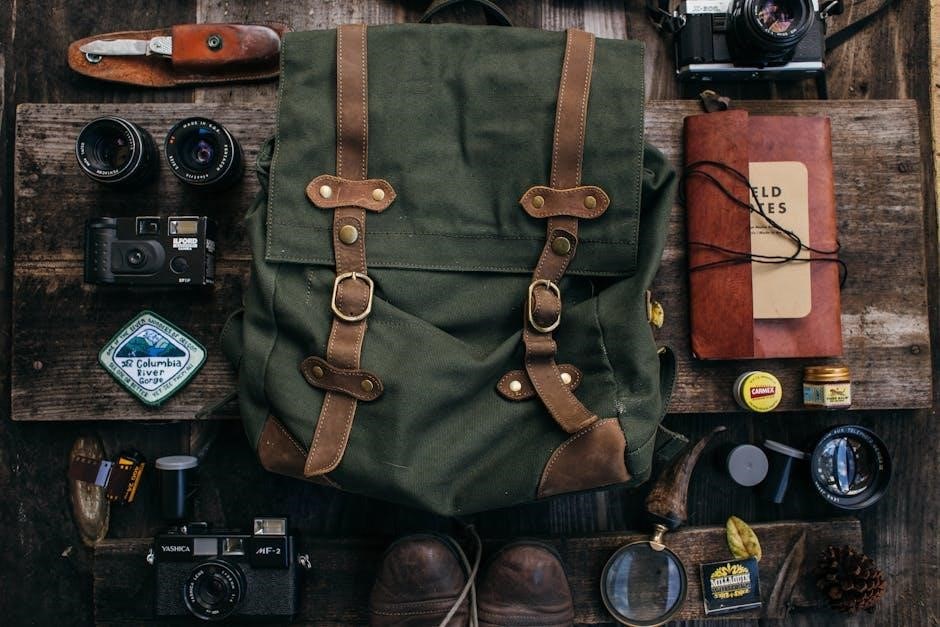
Layering for Different Weather Conditions
Layering clothing is essential for adapting to varying weather conditions during hikes. A base layer of moisture-wicking fabric regulates body temperature‚ while insulating mid-layers provide warmth. Waterproof jackets shield against rain and wind. This system allows hikers to adjust clothing based on activity level and weather changes‚ preventing overheating and hypothermia. Merino wool or synthetic fabrics are ideal for base layers due to their breathability. Fleece or down jackets serve as effective mid-layers‚ and waterproof shells ensure protection in wet conditions. Proper layering enhances comfort and safety‚ making it a cornerstone of the 10 Essentials for Hiking.
Choosing the Right Fabrics
Selecting the right fabrics for hiking clothing is crucial for comfort and performance. Moisture-wicking materials like merino wool or synthetic blends are ideal for base layers‚ as they keep skin dry. Insulating layers should be lightweight yet warm‚ with options like fleece or down. Waterproof and breathable fabrics‚ such as Gore-Tex or similar technology‚ are essential for outerwear to protect against rain and wind. Durability is also key‚ especially for items like hiking pants‚ which may face rough terrain. Choosing fabrics that balance breathability‚ moisture management‚ and durability ensures hikers stay comfortable and protected in various conditions‚ aligning with the principles of the 10 Essentials for Hiking.
Headlamp or Flashlight
A reliable light source is vital for hiking‚ especially after dark. Choose a headlamp or flashlight with LED bulbs for longer battery life and red light mode to preserve night vision. Always carry extra batteries and ensure the device is waterproof for unexpected conditions.
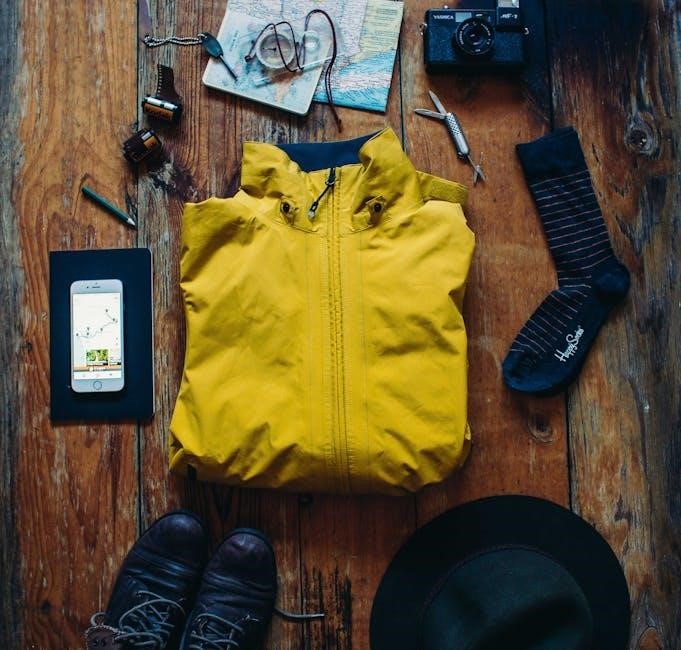
Why Light Sources Are Essential
A headlamp or flashlight is crucial for hiking safety‚ especially after dark. It provides visibility in low-light conditions‚ helping you navigate trails‚ avoid obstacles‚ and set up camp. A reliable light source also signals your presence to others‚ reducing accidents. LED bulbs are preferred for their energy efficiency and longer lifespan. Red light mode preserves night vision‚ while waterproof designs ensure functionality in rain or snow. Always carry extra batteries to avoid being left in the dark. A light source is not just a convenience; it’s a lifeline in emergencies‚ ensuring you can communicate and find your way safely. Never hike without one.
Best Practices for Using Light Sources
Always pack extra batteries to prevent your light from failing during a hike. Use red light mode at night to preserve your natural vision. Keep your flashlight or headlamp easily accessible. Avoid shining lights directly at people or wildlife to prevent disorientation. Regularly check the battery life and condition of your light source. Consider waterproof designs for reliability in wet conditions. Carry a backup light‚ like a small flashlight‚ as an extra precaution. Test your light before heading out to ensure it’s functioning properly. By following these practices‚ you can maximize the effectiveness of your light source and stay safe in the wild.
First Aid Kit
A first aid kit is crucial for treating injuries and preventing infections. It should include bandages‚ antiseptic wipes‚ pain relievers‚ blister care‚ and medical tape.
Essential Items in a First Aid Kit
A well-stocked first aid kit is vital for addressing minor injuries and preventing more serious issues. It should include bandages of various sizes‚ antiseptic wipes‚ pain relievers‚ and blister care items like moleskin. Add gloves for protection‚ scissors for cutting bandages‚ and tweezers for removing splinters. Medical tape‚ gauze pads‚ and a first aid manual are also crucial. These items help hikers respond effectively to cuts‚ sprains‚ and other common injuries. A properly equipped kit ensures preparedness for unexpected situations‚ making it a cornerstone of hiking safety.
Basic First Aid Techniques
Mastering basic first aid techniques is crucial for addressing injuries during a hike. Start by cleaning wounds with antiseptic wipes and applying antibiotic ointment to prevent infection. Cover wounds with bandages or dressings to protect them. For burns‚ cool the area with water and apply topical creams if available. In case of sprains or twists‚ use the RICE method: Rest‚ Ice‚ Compression‚ and Elevation. Always monitor for signs of infection‚ such as redness or swelling‚ and seek professional help if symptoms persist. These techniques‚ combined with the right supplies‚ can help hikers respond effectively to common injuries and ensure a safer outdoor experience.

Emergency Shelter
Emergency shelter includes a tent‚ tarp‚ or space blanket to protect against harsh weather conditions‚ preventing hypothermia and ensuring safety until help arrives.
Types of Shelter Options
Common emergency shelter options include lightweight tents‚ tarps‚ and bivy sacks. A tent offers full protection from wind and rain‚ while a tarp provides a simpler canopy. Bivy sacks are compact and designed for minimalist protection. Space blankets or emergency bivvy bags are ultra-lightweight options for unexpected nights outdoors. Additionally‚ natural shelters like caves or lean-tos can be used if available. Always choose a shelter that balances weight‚ durability‚ and ease of setup to ensure quick protection in bad weather or darkness.
How to Set Up Emergency Shelter
To set up emergency shelter‚ start by selecting a flat‚ dry spot protected from wind and rain. Clear the area of rocks‚ leaves‚ and twigs for a smooth surface. If using a tent‚ attach poles securely and stake it down firmly. For a tarp‚ tie corners to trees or poles using rope or cordage. Bivy sacks require minimal setup—simply unroll and close the top for protection. Use stakes‚ rocks‚ or logs to anchor edges. Always ensure proper ventilation to prevent condensation buildup. If natural shelter is unavailable‚ create a lean-to with branches and a tarp. Efficiency and safety are key to staying dry and warm during an unexpected stay outdoors.
Fire Starters
Matches‚ lighters‚ and fire starters are crucial for warmth‚ cooking‚ and signaling. Always store matches in a waterproof container to ensure reliability in wet conditions.
Matches‚ Lighters‚ and Fire Starters
Matches‚ lighters‚ and fire starters are indispensable for starting a fire‚ which can provide warmth‚ cook food‚ and signal for help. Always carry multiple options to ensure reliability in various conditions.
Safety Tips for Building a Fire
When building a fire‚ choose a safe location away from flammable materials. Clear leaves and debris‚ and use rocks to contain the fire. Keep water nearby to extinguish it completely. Avoid building fires in dry or windy conditions to prevent wildfires. Ensure the fire is fully out before leaving it unattended. Always follow local fire safety guidelines and regulations. Proper fire management is crucial for protecting the environment and ensuring a safe hiking experience. By following these tips‚ hikers can enjoy the benefits of a fire while minimizing risks and preserving nature.

Extra Food and Water
Carry extra food and water for emergencies. Choose lightweight‚ high-energy options like dry fruits and jerky. Include water purification tablets or a filter for safe hydration.
Importance of Carrying Enough Supplies
Carrying sufficient food and water is vital for maintaining energy levels and preventing dehydration. Hiking expends significant calories‚ and having extra rations ensures you can sustain yourself during delays or unexpected situations. Dehydration can quickly lead to fatigue‚ dizziness‚ and impaired judgment‚ increasing the risk of accidents. Additionally‚ in case of an emergency‚ such as getting lost or injured‚ having extra supplies can help you survive until help arrives. Always pack more than you think you’ll need‚ especially for longer hikes or unpredictable weather conditions. This precaution ensures your safety and comfort throughout the journey.
Choosing the Right Food and Water
Selecting the right food and water for hiking is crucial for energy and hydration. Opt for lightweight‚ high-calorie foods like energy bars‚ nuts‚ and dried fruits‚ which are easy to carry and provide sustained energy. Avoid perishable items that may spoil quickly. For water‚ consider both water bottles and hydration bladders for convenience. Always carry a water purification method‚ such as a filter or tablets‚ to ensure safe drinking water from natural sources. Pack at least one gallon of water per person per day‚ adjusting for climate and activity level. Proper hydration and nutrition are essential for maintaining stamina and preventing fatigue during your hike.
Multi-Purpose Tool
A multi-purpose tool is a compact‚ versatile device offering various functions like cutting‚ tightening‚ and opening‚ making it indispensable for unexpected challenges during a hike.
Uses of a Multi-Purpose Tool
A multi-purpose tool is designed to handle a wide range of tasks during a hike. It can be used for cutting branches‚ repairing gear‚ tightening loose screws‚ and even opening cans. The tool often includes features like pliers‚ scissors‚ a knife‚ and screwdrivers‚ making it versatile for various situations. In emergencies‚ it can help with first aid tasks‚ such as cutting bandages or removing splinters. Additionally‚ some tools include a fire starter or whistle‚ which can be crucial for signaling help. Its compact size and durability make it an essential item for any hiker‚ ensuring preparedness for unexpected challenges.
How to Choose the Right Tool
When selecting a multi-purpose tool for hiking‚ consider durability‚ weight‚ and functionality. Look for tools made from high-quality materials like stainless steel or titanium‚ which offer strength without adding bulk. Ensure the tool includes essential features like pliers‚ scissors‚ and a knife‚ while avoiding unnecessary attachments that increase weight. Evaluate the tool’s ergonomics and ease of use‚ as it should be comfortable to handle. Popular brands like Leatherman and Gerber offer reliable options. Additionally‚ consider the specific needs of your hike‚ such as whether you need a fire starter or whistle. A well-chosen tool should balance practicality and versatility‚ making it a valuable asset for your hiking adventures.
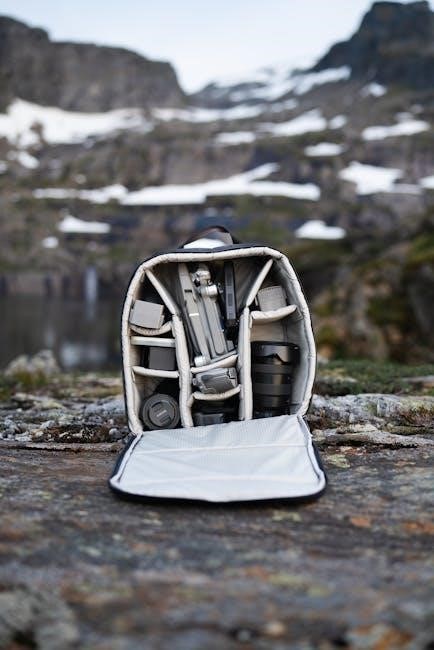
Sun and Insect Protection
Essential items include sunglasses‚ sunscreen‚ insect repellent‚ and a sun hat. Reapply sunscreen every two hours and use DEET-based repellents for optimal protection against bugs and UV rays.
Essential Items for Protection
Key protective gear includes broad-spectrum sunscreen with high SPF‚ UV-blocking sunglasses‚ and a wide-brimmed hat to shield against harmful sun rays. Insect repellent containing DEET or picaridin is vital to prevent bug bites. Additionally‚ lightweight‚ breathable clothing with built-in UPF protection can minimize sun exposure. Including a scarf or bandana adds versatility for covering skin when needed. These items collectively ensure hikers are safeguarded from both sunburn and insect-borne illnesses‚ enhancing overall safety and comfort during their outdoor adventures. Proper protection is crucial for enjoying nature without compromising health.
Best Practices for Sun and Insect Protection
Apply sunscreen liberally 15–30 minutes before exposure and reapply every two hours‚ especially after sweating or swimming. Wear UV-blocking sunglasses and a hat with a wide brim to cover sensitive areas. For insect protection‚ spray repellents on exposed skin and clothing‚ avoiding eyes and mucous membranes. Reapply as directed‚ typically every 6–8 hours. Consider treating clothing with permethrin for added defense against ticks. Stay on marked trails to avoid areas with high insect activity and avoid peak sun hours (10 AM–4 PM) to minimize sun exposure. These practices help prevent sunburn‚ skin damage‚ and insect-borne illnesses‚ ensuring a safer hiking experience.

Additional Tips for Hiking Preparedness
Check weather forecasts‚ inform someone of your plans‚ and stay within your skill level to ensure a safe and enjoyable hiking experience.
How to Pack the Essentials Efficiently
Packing the 10 essentials requires thoughtful organization to ensure accessibility and comfort. Start by distributing heavier items like water and extra clothing near your back for better weight distribution. Use compression bags or stuff sacks to minimize bulk and keep gear dry. Place frequently needed items‚ such as your first aid kit and navigation tools‚ in easy-to-reach pockets. Consider separating items into categories (e.g.‚ shelter‚ lighting‚ and food) for quicker access. Roll your clothes to save space and reduce wrinkles. Finally‚ secure loose items with elastic cords to prevent shifting during your hike. Efficient packing ensures a safer‚ more enjoyable experience.
Understanding the Evolution of the 10 Essentials
The 10 Essentials for Hiking were first introduced in the 1930s by The Mountaineers‚ a Seattle-based hiking club‚ as a simple list of critical items to ensure safety. Initially focused on survival and emergency response‚ the list has evolved over time to reflect advancements in technology and changing outdoor needs. Today‚ the essentials are organized into functional systems rather than individual items‚ emphasizing preparedness for diverse scenarios. This evolution ensures hikers are equipped to handle modern challenges‚ from unpredictable weather to navigational complexities‚ while maintaining the core principle of safety and self-reliance in the wilderness.
Adhering to the 10 essentials ensures a safe and enjoyable hiking experience. These items help prevent accidents and enable effective response when emergencies arise. Always carry them to stay prepared and make hiking safer and more rewarding for everyone.
Final Thoughts on Hiking Safety
Preparedness is key to a safe and enjoyable hiking experience. The 10 essentials serve as a cornerstone for responsible hiking‚ ensuring hikers are equipped to handle emergencies and unexpected situations. By carrying items like appropriate footwear‚ navigation tools‚ and a first aid kit‚ hikers demonstrate a commitment to safety and self-reliance. These essentials not only prevent accidents but also provide confidence to explore nature fully. Remember‚ hiking is about connecting with the outdoors while being mindful of its challenges. Always pack the 10 essentials‚ stay informed‚ and respect the environment to ensure a positive experience for yourself and others. Safe trails await!

